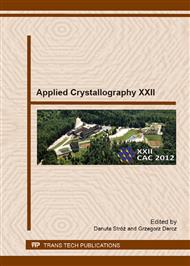p.280
p.284
p.288
p.292
p.296
p.302
p.306
p.310
p.315
Influence of Copper Addition on Glass Forming Ability, Thermal Stability, Structure and Magnetic Properties of Fe-Co-Based BMGs
Abstract:
The aim of the paper was investigation of the effect of Cu addition on glass forming ability (GFA), thermal stability, structure and magnetic properties of Fe-Co-based bulk metallic glasses (BMGs). The raw materials used in this experiment for the production of BMGs were pure Fe, Co, Cu and industrial Fe-B, Fe-Si, Fe-Nb ferroalloy. Investigations were carried out on BMGs in rods shaped with square section with side of 1.5mm. The structure of the investigated BMGs in rod form is amorphous. The addition of small amounts of Cu is effective in changing GFA and magnetic properties. The melting temperature - Tm remained almost constant for both investigated alloy. Two alloy compositions are at or very close to the eutectics, what according to ref. [1] should guarantee the best metallic glass-forming alloys. The investigated alloys have good soft magnetic properties. The successful synthesis of the Fe36.00Co36.00B19.00Si5Nb4 and Fe35.75Co35.75B18.90Si5Nb4Cu0.6 alloys with high GFA and good soft magnetic properties by using starting industrial alloys are encouraging for the future industry applications.
Info:
Periodical:
Pages:
296-301
Citation:
Online since:
June 2013
Authors:
Price:
Сopyright:
© 2013 Trans Tech Publications Ltd. All Rights Reserved
Share:
Citation:


